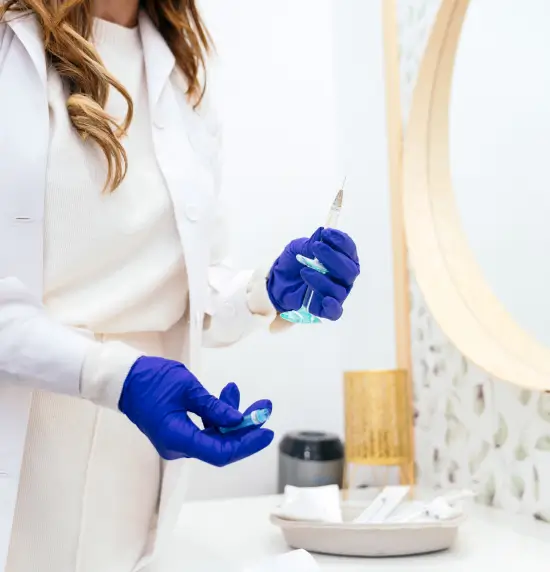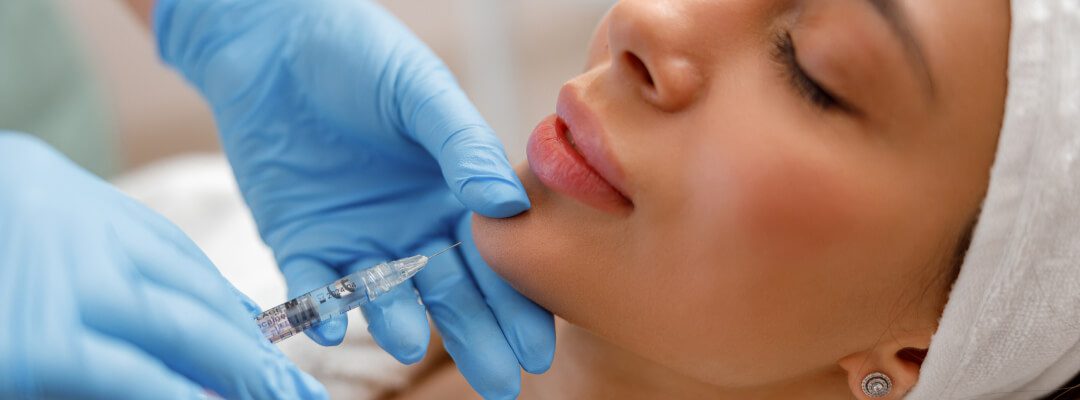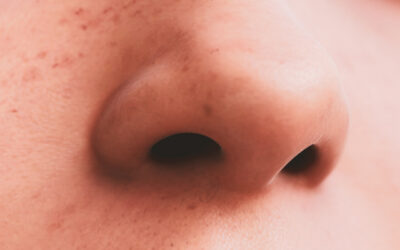Facial feminization with hyaluronic acid is a non-surgical option for transgender women seeking to harmonize and soften their facial features, achieving a look more aligned with their gender identity. Hyaluronic acid is a type of dermal filler that allows for modifications in certain facial areas to provide features with lines more commonly identified as feminine. Thanks to its immediate results, hyaluronic acid has become an essential tool for women who wish to modify their features without undergoing surgery.
What is hyaluronic acid?
Hyaluronic acid is a biocompatible and resorbable substance naturally found in our body, especially in the skin, joints, and eyes. Its primary function is to retain water, providing hydration and elasticity to tissues. This makes it an ideal ally for hydrating the skin. Additionally, it can add volume, making it an excellent option for treating different facial areas and achieving softer, more typically feminine features.
Types of hyaluronic acid
There are different types of hyaluronic acid, which vary in molecular weight and their ability to penetrate the skin. Low molecular weight hyaluronic acid can penetrate deeper into the skin, providing deep hydration and stimulating collagen production. Meanwhile, high molecular weight hyaluronic acid retains moisture, creating a filling effect.
Treatment with hyaluronic acid is minimally invasive and causes very little discomfort. Local or topical anesthesia can be used, but many treatments do not even require it. This is why it is one of the most sought-after treatments in non-surgical facial feminization.
Which areas can be treated with hyaluronic acid?
Hyaluronic acid offers exceptional versatility in facial feminization, allowing multiple areas to be treated to achieve facial balance and harmony that highlight features traditionally associated with femininity.
Some of the most common areas that can be treated include:
- Temples: The specialist can strategically use hyaluronic acid to fill sunken temples and achieve a rounder facial contour. Additionally, in cases of skin laxity, it can help improve skin firmness.
- Cheekbones: Enhancing cheek volume to create a more elevated and defined appearance.
- Eyes: Hyaluronic acid can fill the tear trough area, softening the features in this region.
- Facial contour: It helps soften facial angles, define the jawline, enhance the cheekbones, and create a more aesthetically feminine oval face.
- Nose: It can refine the nasal tip, slim the bridge, improve symmetry and the nasal profile, and correct minor imperfections or irregularities. This technique is also known as non-surgical rhinoplasty.
- Lips: It allows for increased volume, contour definition, asymmetry correction, and a more pronounced Cupid’s bow, resulting in fuller, well-defined lips with a harmonious shape.
- Jawline and chin: It helps reduce the angular appearance of the jaw and refine the chin for a more stylized profile.
- Texture: Skin texture is also important in the feminization process. Hyaluronic acid, combined with vitamins and other trace elements, applied through facial mesotherapy, improves skin quality, providing greater elasticity, smoothness, and vitality.
It is important for each treatment to be personalized and performed by an aesthetic doctor experienced in facial feminization.

Benefits of hyaluronic acid in facial feminization
The main benefits of hyaluronic acid in facial feminization include:
- Natural results: Hyaluronic acid integrates naturally into the tissues. In the hands of an experienced specialist in facial feminization, the results are balanced, soft, and feminine.
- Immediate results: The effects of the treatment are visible from the very first moment. While they may vary slightly in the following days, changes can be appreciated after the first session.
- Minimally invasive procedure: Since it does not require surgery, recovery is quick and simple. In some cases, patients can return to their normal routine immediately after treatment.
- Total customization: The treatment is adapted to the needs of each patient, ensuring natural results that align with their goals.
- Reversibility: If necessary, hyaluronic acid can be dissolved using an enzyme called hyaluronidase.
- Progressive improvement: Over time, hyaluronic acid stimulates collagen production, improving skin quality.
- Safe and effective: It is a safe and well-tolerated treatment that achieves excellent results.
Differences between surgical and non-surgical facial feminization
Both facial feminization surgery and non-surgical feminization aim to achieve a face more aligned with gender identity, but there are key differences between the two:
Facial feminization surgery:
- Procedures: These are more invasive procedures that may include forehead feminization or frontoplasty, hairline advancement, jaw contouring, feminizing rhinoplasty, fat transfer, chin feminization, or lip lift, among others.
- Results: Surgical facial feminization results are permanent and allow for more significant facial changes.
- Recovery: It requires a longer postoperative period and specific care after surgery.
- Cost: Generally, surgical procedures have a higher cost.
Non-surgical facial feminization (with hyaluronic acid):
- Procedures: Uses hyaluronic acid as a dermal filler for subtle and gradual modifications. It is less invasive but treats more superficial areas than surgery.
- Results: Typically temporary, lasting between 6 and 18 months, depending on the treated area and the patient’s metabolism.
- Recovery: Minimal, with the possibility of resuming daily activities immediately.
- Cost: More affordable than surgery.
How long do the results of facial feminization with hyaluronic acid last?
The results of facial feminization with hyaluronic acid are always temporary, usually lasting between 6 and 18 months, depending on various factors such as:
- The treated area (for example, the lips tend to absorb hyaluronic acid more quickly than other areas like the cheekbones).
- The patient’s metabolism (some people metabolize hyaluronic acid faster).
- The type of hyaluronic acid used.
- Post-treatment care.
To maintain results, it is recommended to undergo periodic touch-ups according to the specialist aesthetic doctor’s recommendations.

Possible side effects of the treatment
Although hyaluronic acid is a safe and well-tolerated treatment, it can sometimes cause mild swelling and redness during the first 24 to 48 hours. Depending on the treated area, small bruises may appear, which usually disappear quickly. Additionally, some people experience sensitivity in the treated areas for a few days.
It is essential to visit a specialized clinic, carefully read the informed consent before treatment, and discuss any questions with the aesthetic doctor both before and after the procedure to follow proper guidelines.
Do you want to learn more about facial feminization with hyaluronic acid? At IM GENDER, we are specialists. Contact us, and we will answer all your questions.






